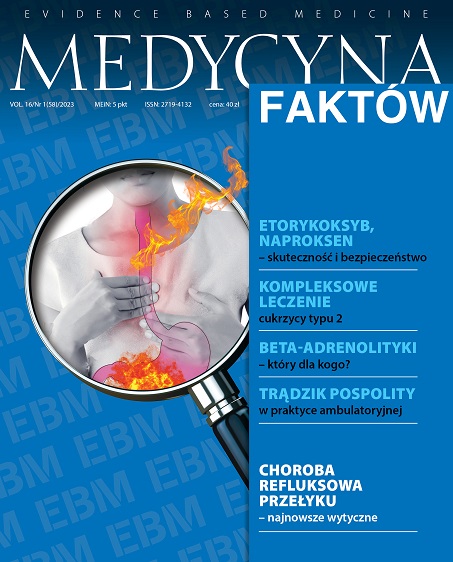5 powodów, dla których warto stosować połączenie estradiolu i dydrogesteronu w hormonalnej terapii menopauzalnej Artykuł przeglądowy
##plugins.themes.bootstrap3.article.main##
Abstrakt
Skuteczną metodą łagodzenia objawów menopauzalnych jest hormonalna terapia menopauzalna. Stosowane są dwa rodzaje: monoterapia estrogenowa lub terapia łączona estrogenowo-progesteronowa. Na rynku dostępnych jest wiele preparatów, różniących się zarówno substancjami czynnymi, jak i schematami, dawkami oraz drogami ich podawania. Pozwala to na indywidualizację terapii i dostosowanie jej do potrzeb danej pacjentki. W niniejszej pracy zaprezentowano cechy charakterystyczne terapii łączonej estradiol + dydrogesteron i możliwości ich wykorzystania w praktyce.
##plugins.themes.bootstrap3.article.details##
Jak cytować
Skrzypulec-Plinta, V., & Zborowska, K. (2023). 5 powodów, dla których warto stosować połączenie estradiolu i dydrogesteronu w hormonalnej terapii menopauzalnej . Medycyna Faktów , 16(1(58), 60-62. https://doi.org/10.24292/01.MF.0123.10
Numer
Dział
Artykuły
Copyright © by Medical Education. All rights reserved.
Bibliografia
1. Woods NF, Mitchell ES. Symptoms during the perimenopause: prevalence, severity, trajectory, and significance in women’s lives. Am J Med. 2005;118(suppl 12B): 14-24.
2. Ren M, Ruan X, Gu L et al. Ultra-low-dose estradiol and dydrogesterone: a phase III study for vasomotor symptoms in China. Climacteric. 2022; 25(3): 286-92.
3. Stevenson JC, Durand G, Kahler E et al. Oral ultra-low dose continuous combined hormone replacement therapy with 0.5 mg 17β-oestradiol and 2.5 mg dydrogesterone for the treatment of vasomotor symptoms: results from a double-blind, controlled study. Maturitas. 2010; 67(3): 227-32.
4. Fournier A, Berrino F, Clavel-Chapelon F. Unequal risks for breast cancer associated with different hormone replacement therapies: results from the E3N cohort study. Breast Cancer Res Treat. 2008; 107(1): 103-11.
5. Abenhaim HA, Suissa S, Azoulay L et al. Menopausal hormone therapy formulation and breast cancer risk. Obstet Gynecol. 2022; 139(6): 1103-110.
6. von Schoultz E, Rutqvist LE; Stockholm Breast Cancer Study Group. Menopausal hormone therapy after breast cancer: the Stockholm randomized trial. J Natl Cancer Inst. 2005; 97(7): 533-5.
7. Vinogradova Y, Coupland C, Hippisley-Cox J. Use of hormone replacement therapy and risk of breast cancer: nested case-control studies using the QResearch and CPRD databases. BMJ. 2020; 371: m3873.
8. Schneider C, Jick SS, Meier CR. Risk of cardiovascular outcomes in users of estradiol/dydrogesterone or other HRT preparations. Climacteric. 2009; 12(5): 445-53.
9. Christenson ES, Jiang X, Kagan R et al. Osteoporosis management in post-menopausal women. Minerva Ginecol. 2012; 64(3): 181-94.
10. Stevenson JC, Panay N, Pexman-Fieth C. Oral estradiol and dydrogesterone combination therapy in postmenopausal women: review of efficacy and safety. Maturitas. 2013; 76(1): 10-21.
11. van de Weijer PH, Scholten PC, van der Mooren MJ et al. Bleeding patterns and endometrial histology during administration of low-dose estradiol sequentially combined with dydrogesterone. Climacteric. 1999; 2(2): 101-9.
12. Ferenczy A, Gelfand MM. Endometrial histology and bleeding patterns in post-menopausal women taking sequential, combined estradiol and dydrogesterone. Maturitas. 1997; 26(3): 219-26.
13. Ferenczy A, Gelfand MM, van de Weijer PH et al. Endometrial safety and bleeding patterns during a 2-year study of 1 or 2 mg 17 beta-estradiol combined with sequential 5-20 mg dydrogesterone. Climacteric. 2002; 5(1): 26-35.
14. Quereux C, Pornel B, Bergeron C et al. Continuous combined hormone replacement therapy with 1 mg 17beta-oestradiol and 5 mg dydrogesterone (Femoston-conti): endometrial safety and bleeding profile. Maturitas. 2006; 53(3): 299-305.
15. Jaakkola S, Lyytinen H, Pukkala E et al. Endometrial cancer in postmenopausal women using estradiol-progestin therapy. Obstet Gynecol. 2009; 114(6): 1197-204.
2. Ren M, Ruan X, Gu L et al. Ultra-low-dose estradiol and dydrogesterone: a phase III study for vasomotor symptoms in China. Climacteric. 2022; 25(3): 286-92.
3. Stevenson JC, Durand G, Kahler E et al. Oral ultra-low dose continuous combined hormone replacement therapy with 0.5 mg 17β-oestradiol and 2.5 mg dydrogesterone for the treatment of vasomotor symptoms: results from a double-blind, controlled study. Maturitas. 2010; 67(3): 227-32.
4. Fournier A, Berrino F, Clavel-Chapelon F. Unequal risks for breast cancer associated with different hormone replacement therapies: results from the E3N cohort study. Breast Cancer Res Treat. 2008; 107(1): 103-11.
5. Abenhaim HA, Suissa S, Azoulay L et al. Menopausal hormone therapy formulation and breast cancer risk. Obstet Gynecol. 2022; 139(6): 1103-110.
6. von Schoultz E, Rutqvist LE; Stockholm Breast Cancer Study Group. Menopausal hormone therapy after breast cancer: the Stockholm randomized trial. J Natl Cancer Inst. 2005; 97(7): 533-5.
7. Vinogradova Y, Coupland C, Hippisley-Cox J. Use of hormone replacement therapy and risk of breast cancer: nested case-control studies using the QResearch and CPRD databases. BMJ. 2020; 371: m3873.
8. Schneider C, Jick SS, Meier CR. Risk of cardiovascular outcomes in users of estradiol/dydrogesterone or other HRT preparations. Climacteric. 2009; 12(5): 445-53.
9. Christenson ES, Jiang X, Kagan R et al. Osteoporosis management in post-menopausal women. Minerva Ginecol. 2012; 64(3): 181-94.
10. Stevenson JC, Panay N, Pexman-Fieth C. Oral estradiol and dydrogesterone combination therapy in postmenopausal women: review of efficacy and safety. Maturitas. 2013; 76(1): 10-21.
11. van de Weijer PH, Scholten PC, van der Mooren MJ et al. Bleeding patterns and endometrial histology during administration of low-dose estradiol sequentially combined with dydrogesterone. Climacteric. 1999; 2(2): 101-9.
12. Ferenczy A, Gelfand MM. Endometrial histology and bleeding patterns in post-menopausal women taking sequential, combined estradiol and dydrogesterone. Maturitas. 1997; 26(3): 219-26.
13. Ferenczy A, Gelfand MM, van de Weijer PH et al. Endometrial safety and bleeding patterns during a 2-year study of 1 or 2 mg 17 beta-estradiol combined with sequential 5-20 mg dydrogesterone. Climacteric. 2002; 5(1): 26-35.
14. Quereux C, Pornel B, Bergeron C et al. Continuous combined hormone replacement therapy with 1 mg 17beta-oestradiol and 5 mg dydrogesterone (Femoston-conti): endometrial safety and bleeding profile. Maturitas. 2006; 53(3): 299-305.
15. Jaakkola S, Lyytinen H, Pukkala E et al. Endometrial cancer in postmenopausal women using estradiol-progestin therapy. Obstet Gynecol. 2009; 114(6): 1197-204.
